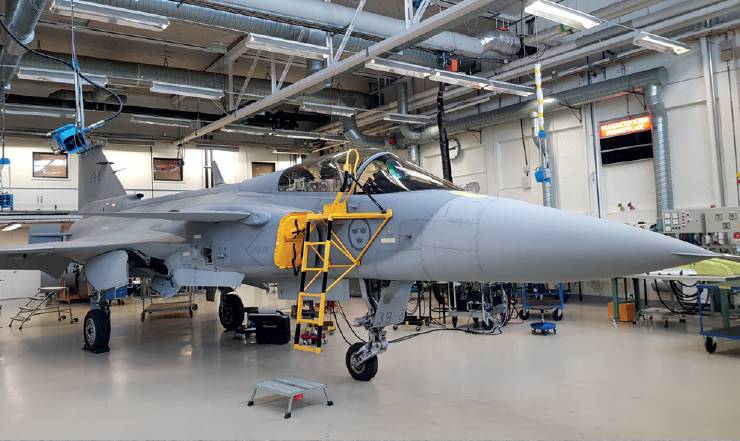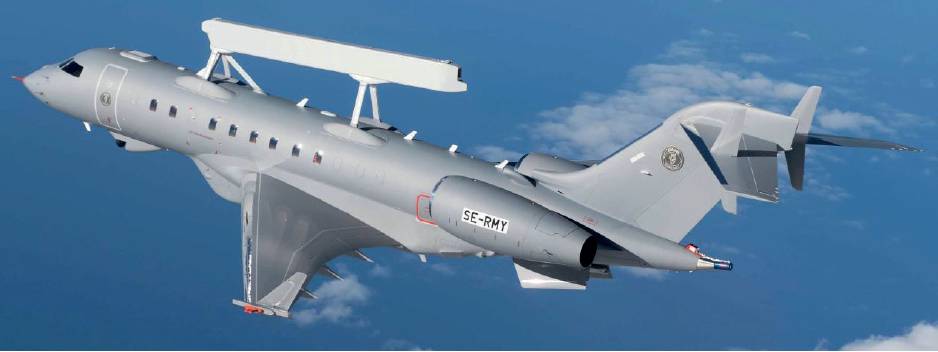DEFENCE Saab
The Swedish perspective
As Scandinavian nations react to increased sabre-rattling from Russia, Saab has been at the forefront of providing hardware to counter it. BETH STEVENSON reports.
 Gripen 39-7.
Gripen 39-7.
Saab is soon to hit a number of milestones within notable key development programmes, ensuring that Sweden’s flagship aerospace manufacturer has competitive offerings to pitch for emerging international requirements.
For the fighter, airborne early warning and advanced trainer markets it is establishing new systems, applying its expertise in aerodynamics, radar and manufacturing that it has generated from years of providing aircraft to its primary customer, the Swedish Air Force but which is now generating more interest further afield as other nations seek the capabilities previously afforded primarily to the company’s domestic customer.
From Sweden’s perspective, however, a rise in the threat from Russia is leading to a boost in defence spending, as the nation is witnessing an increase in jamming and aggression from Russia and, in some cases, its aircraft are getting as close as 20 metres to Swedish fighters carrying out quick reaction alert sorties in response to Moscow entering airspace that it should not.
This is one issue that is leading to a requirement for a robust arsenal of military capabilities, specifically aerial ones that can deter the aggressive infringement of Russian aircraft into Swedish and neighbouring allies’ airspace.
To this end, in May 2019 the Swedish Defence Commission released a white paper outlining the required military capabilities required to sustain the nation’s edge over what are perceived to be its adversaries, aiming to increase spending to SEK84bn from 2025.
This represents 1.5% of GDP and, while Sweden is not a member of NATO, it brings the nation closer to a target of 2% that is being aimed at by its neighbours that are signed up to the alliance.
Included in the list of requirements to fulfil Sweden’s security needs in the future includes eight fighter squadrons and one MALE/HALE UAV squadron, as well as new respective airborne early warning and transport aircraft in the 2025/30 timeframe.
It is also seeking a trainer replacement in the future for its 40-strong fleet of Saab 105 aircraft. A number of these identified requirements are being developed by Saab, albeit at the moment targeting overseas markets.
For example, the company is codeveloping the clean sheet design T-X trainer alongside Boeing for the US Air Force, a collaboration that in years to come could be sold on the international market and fulfil a future Swedish trainer requirement.
It is also developing new surveillance aircraft, which could also join the Swedish inventory in the future.
Saab officially launched two new surveillance concepts based on business jets during the Singapore Air Show in 2016, namely the airborne early warning and control aircraft, GlobalEye and the maritime patrol aircraft, Swordfish.
 A Gripen
undergoing maintenance in
Linkoping. Saab
A Gripen
undergoing maintenance in
Linkoping. Saab
Both are based on the Bombardier Global 6000 family airframe – Swordfish was at one point being offered for the Q400 but an identified lack of interest in turboprops for maritime patrol missions has led to that concept being somewhat shelved – and while the GlobalEye programme is in full swing ahead of deliveries to its Emirati launch customer, development of the MPA is temporarily on hold.
Speaking to media at its Linköping, Sweden site in May, the company said that, while it is not explicitly pushing Swordfish to customers, it is not shelved and is an option should an air force require it.
GlobalEye development is progressing, however, and the company said it is in the process of building the third and final system for the UAE, the first example of which is undergoing certification testing ahead of an undisclosed first delivery date that is believed to be April 2020.
“We are on track and very happy with the performance,” Lars Tossman, Head of Radar Solutions at Saab, said. While it was confirmed that the third aircraft is in development, timeframes for its first flight and delivery were undisclosed.
The second example, meanwhile, carried out its maiden flight in January 2019, following the first flight of the lead example in March 2018.
Certification testing is nearing completion, and the aircraft will be delivered to the UAE as they are completed.
Initial deliveries of the ground systems, that will support the AEW&C aircraft, have been carried out, Tossman added, noting that the aircraft is behaving just like the VIP version of the Global 6000/6500 during testing, which is a feat considering the number of systems that it has to carry on board.
GlobalEye carries the extended range version of the company’s Erieye AEW radar, a sensor that has been utilised on other aircraft including the Saab 2000 and 340, the latter of which is currently operated by the UAE.
It has not yet been decided what the UAE will do with its incumbent fleet of 340-based Erieye AEWs, be it to sell them it on or operate them it in parallel to the forthcoming GlobalEyes.
The new aircraft also carries Leonardo’s Seaspray active electronically-scanned radar, an X-band capability that was deemed a requirement for the system. Another notable development by Saab is the Gripen E/F fighter, a derivative of the C/D model that is in service with the Swedish air force and a number of other nations across the world.
Development of the new variant is nearing completion, and run tests are being carried out on the 39-10 example that in the coming weeks is set to join the fleet of aircraft undergoing test and evaluation.
Serial delivery of the E-model began at the beginning of 2019, which is setting the company up to be able to deliver the 60 examples on contract for the Swedish air force and the 28 on order for the Brazilian air force (which is also acquiring eight F-model twin-seat trainer variants).
 The
GlobalEye. SaabWhile derived from previous iterations of the fighter, Saab claims that Gripen E will be a new system entirely, as it introduces more networked sensor capability and upgradeability to the design.
The
GlobalEye. SaabWhile derived from previous iterations of the fighter, Saab claims that Gripen E will be a new system entirely, as it introduces more networked sensor capability and upgradeability to the design.
It is being pitched for a number of tenders underway around the world from air forces seeking to upgrade their fighter fleets, including Canada, Finland, Switzerland and India, all of which have released requests for bids or are expected to issue them in due course. However, on 13 June, the Gripen E was dropped from the Swiss fighter contest on the basis that all fighters had to be operationally ready in 2019.
Saab will have two available production lines to fulfil export custom for Gripen E, namely at its facility in Linköping and via the presence it has in Brazil under the terms of its technology transfer commitments in the country that is being delivered alongside its partner, Embraer.
The Swedish OEM’s President and CEO Håkan Buskhe told media that the company is confident it will sell 400 Gripen Es via these ongoing requirements, so Saab is planning for the potential to deliver in excess of the 24 aircraft per annum that it is initially aiming to manufacture.
Brazil could also potentially order two more batches of 36, he said, while Finland and Switzerland are some 100 aircraft combined, and Buskhe noted that the lead time on the Gripen E will be approximately five years.
He added that the company is targeting growth of 5% per annum over the next six years, which will be helped by what Saab considers a smart approach to its markets, products, and research and development.
“We are the only ones in the Western world building a new trainer and fighter,” Buskhe noted. “We are focusing on the delivery of complex systems in a short period of time.”